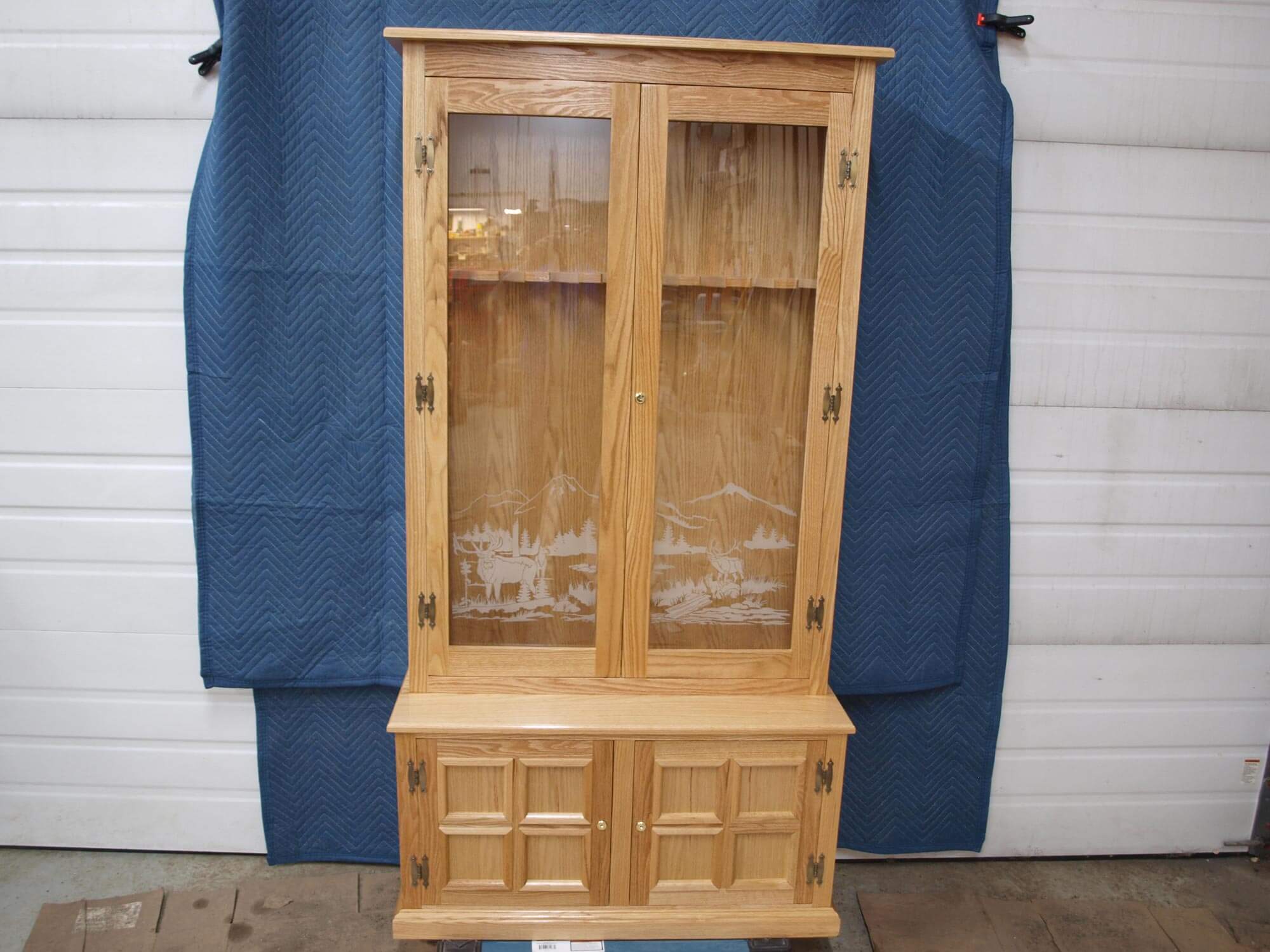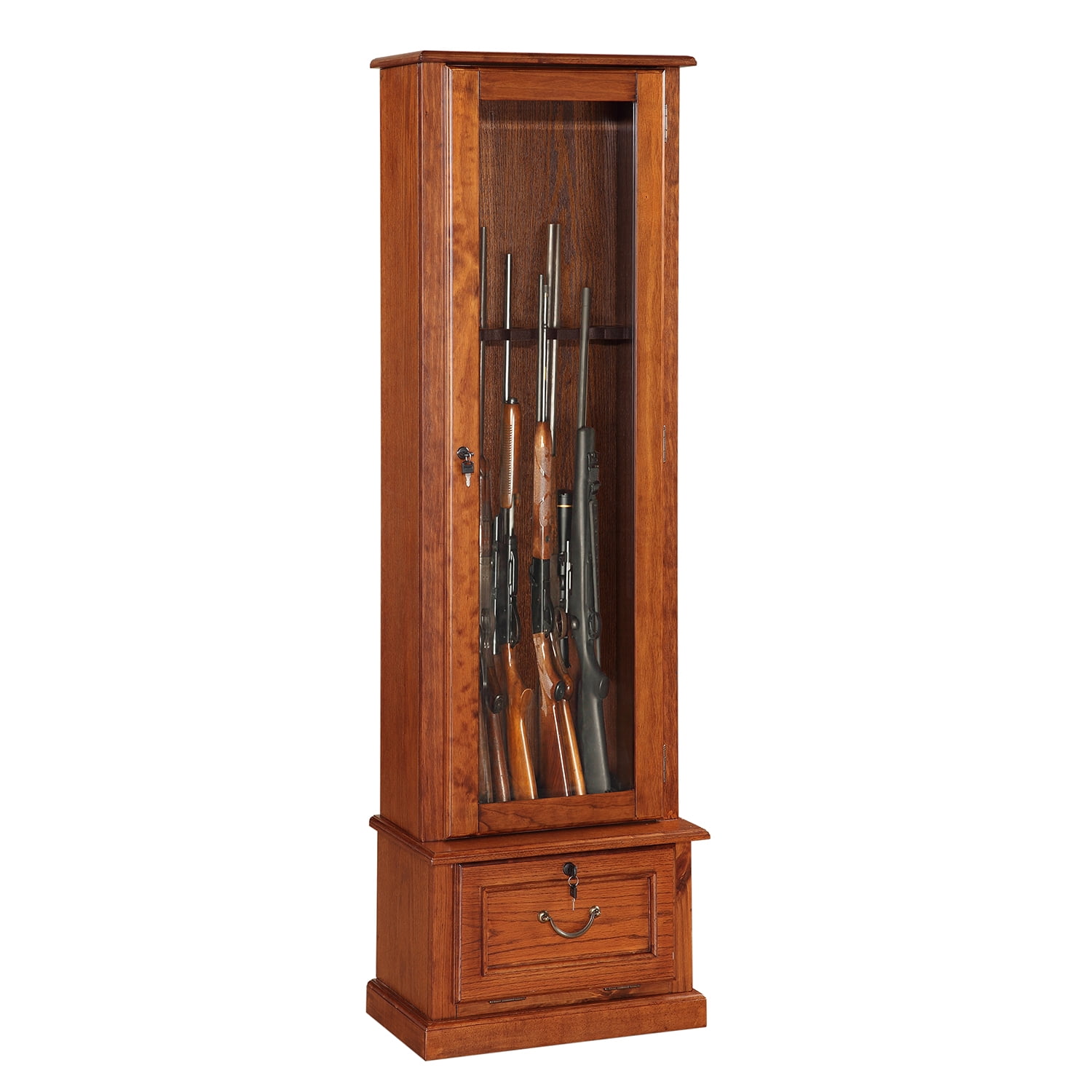Design & Aesthetics of Wood Gun Cabinets with Etched Glass: Wood Gun Cabinet With Etched Glass

So, you’re thinking about a gun cabinet, huh? Not just any old gun cabinet, but one that screams “sophistication” and “I appreciate fine craftsmanship,” all while keeping your firearms safely tucked away. Etched glass and beautiful wood? We’re talking serious style points here. Let’s dive into the glorious world of design and aesthetics.
Wood Types and Etching Patterns in Different Cabinet Styles
The right combination of wood and etched glass can transform a simple storage unit into a stunning piece of furniture. Think of it as a marriage of materials – a beautiful union of form and function. The possibilities are as endless as the types of wood and etching designs available. Let’s explore some examples using a handy table.
| Traditional | Modern | Rustic | Contemporary |
|---|---|---|---|
| Dark walnut or mahogany, with a deeply etched floral or scrollwork pattern. Imagine a classic, almost regal feel. | Light oak or maple, with a minimalist geometric pattern etched into the glass. Clean lines and a sleek look are key. | Reclaimed barn wood, perhaps with knot holes, paired with a simple, almost primitive etched design – maybe a branch or leaf. Think rugged charm. | Ebony or wenge, with an abstract, almost chaotic etching. This is all about bold statements and modern artistry. |
Impact of Wood Finishes on Overall Appearance
The finish you choose for your wood gun cabinet can significantly impact its overall aesthetic. It’s not just about protection; it’s about enhancing the beauty of the wood and the etched glass. A simple stain can highlight the natural grain, while a glossy varnish or lacquer will create a more polished and modern look.
A dark stain on a cherry wood cabinet with a light etched design, for instance, creates a striking contrast. Imagine the deep, rich color of the wood setting off the delicate etched pattern. On the other hand, a clear varnish on a light oak cabinet with a bold geometric etching emphasizes the clean lines and modern feel. It’s all about finding the perfect balance.
Visual Appeal of Etched Glass Designs with Different Wood Species
The interplay between the etched glass and the wood species is crucial. The right combination can elevate your cabinet from functional to phenomenal. Let’s explore some pairings:
- Floral Etched Glass with Cherry Wood: The rich, warm tones of cherry wood complement the delicate details of a floral etching, creating a classic and elegant look. Think a sophisticated hunting lodge.
- Geometric Etched Glass with Maple Wood: The clean lines of geometric etching pair beautifully with the light, airy feel of maple, resulting in a modern and minimalist aesthetic. Perfect for a contemporary home.
- Abstract Etched Glass with Walnut Wood: The deep, dark color of walnut provides a dramatic backdrop for an abstract etched design, creating a bold and artistic statement. This is for the homeowner who wants to make a statement.
- Simple Etched Glass with Reclaimed Wood: The rustic charm of reclaimed wood is enhanced by a simple, understated etched glass design, creating a unique and character-filled piece. It’s the kind of cabinet that tells a story.
Functionality & Features of Wood Gun Cabinets with Etched Glass

Alright, buckle up, buttercup! We’ve talked aesthetics, now let’s get down to brass tacks – or should I say, brass-plated locks? This section dives into the nitty-gritty of what makes a wood gun cabinet with etched glass not just pretty, but also practical and, dare I say, *secure*.
Wood gun cabinet with etched glass – Think of it this way: a beautiful cabinet is like a delicious cake. But if the cake is made of sawdust and glue, it’s not going to hold up to scrutiny, is it? The functionality and features are the ingredients that make the cake (or gun cabinet) truly worthwhile.
Security Features
Security is paramount, people! We’re not just talking about keeping your collection dust-free; we’re talking about keeping your firearms safely stored and out of the wrong hands. These features are the key ingredients to a secure gun cabinet.
- Locking Mechanisms: From simple key locks to sophisticated electronic combinations and even biometric systems, the locking mechanism is your first line of defense. A high-quality, multi-point locking system is a must, offering superior resistance to forced entry. Imagine a burglar trying to pry it open – they’d be there all night!
- Hinges: Don’t underestimate the hinges! Hidden hinges are far superior to exposed ones, preventing easy access for tampering. Think of them as the secret passage to your firearm fortress. A burglar won’t even know where to start!
- Interior Organization: This isn’t just about neatness; it’s about safety. Adjustable shelves, foam lining, and gun racks keep your firearms organized and prevent them from shifting or scratching each other. A well-organized cabinet is a happy cabinet – and a happy owner!
Ventilation and Humidity Control
Okay, so you’ve got a secure cabinet, but what about the precious cargo inside? Firearms, especially those with wooden stocks, are sensitive to temperature and humidity fluctuations. Ignoring this is like leaving your prized vintage car out in a hailstorm.
- Assess the Environment: Check the humidity and temperature levels in the room where the cabinet will be placed. A hygrometer and thermometer are your best friends here.
- Choose the Right Location: Avoid areas with direct sunlight, extreme temperature fluctuations, or high humidity. Think of it as finding the perfect climate for your firearms.
- Ventilation: Ensure your cabinet has adequate ventilation to prevent moisture buildup. Small vents or even strategically placed holes can make a big difference. Don’t suffocate your guns!
- Humidity Control (Optional): For extra protection, consider using a dehumidifier or humidity control packs inside the cabinet, especially in damp climates. Think of it as a personal spa day for your guns.
- Regular Monitoring: Regularly check the humidity and temperature levels inside the cabinet to ensure optimal conditions. It’s like checking your pet’s temperature – you need to keep an eye on it.
Size and Configuration Comparison
Now, let’s talk size. Choosing the right size is like choosing the right pair of shoes – you need a good fit! Too small, and you’ll be cramped; too big, and you’ll waste space. This table compares different sizes and configurations.
| Size (Approximate) | Configuration | Storage Capacity (Approximate) | Space Requirements |
|---|---|---|---|
| Small (36″H x 24″W x 12″D) | Single door, single shelf | 4-6 long guns | Minimal space |
| Medium (60″H x 36″W x 18″D) | Double door, multiple shelves | 8-12 long guns | Moderate space |
| Large (72″H x 48″W x 24″D) | Double door, multiple shelves, drawers | 12+ long guns, handguns, accessories | Significant space |
| Custom | Variable, tailored to specific needs | Variable, highly customizable | Variable, depends on design |
Manufacturing & Materials of Wood Gun Cabinets with Etched Glass

So, you want to know the nitty-gritty of building these beauties? Let’s dive into the woods (pun intended!), the glass, and the glorious process of bringing them to life. It’s more than just hammering and gluing, my friend!
The choice of wood and the etching technique significantly impact the cabinet’s overall quality, aesthetics, and, of course, the price tag. A cheap cabinet might look like a cheap cabinet, and a high-end piece screams sophistication (and often, a hefty price). Let’s explore the details!
Wood Selection for Gun Cabinets
The type of wood used is a major factor determining both the look and the longevity of your gun cabinet. Think of it like choosing the right wood for a fine violin – the wrong choice, and you’ve got a squeaky, unreliable instrument. Here’s a breakdown of popular choices:
| Wood Type | Durability | Aesthetic Qualities | Approximate Cost (per board foot) |
|---|---|---|---|
| Oak | High; very strong and resistant to wear | Classic, warm tones; strong grain patterns; can be stained various colors | $8-$20 |
| Walnut | High; dense and durable | Rich, dark brown; beautiful grain; luxurious appearance | $15-$40 |
| Cherry | Moderate; susceptible to dents and scratches if not properly finished | Warm reddish-brown tones; beautiful grain; ages gracefully | $12-$30 |
| Maple | High; very hard and dense | Light to medium color; fine, even grain; clean, modern look | $7-$18 |
Note: Prices are estimates and can vary widely based on grade, availability, and location. Always consult with a lumber supplier for accurate pricing in your area.
Etching Glass Techniques, Wood gun cabinet with etched glass
Now, let’s talk about the etched glass – the sophisticated, classy touch that elevates a simple cabinet to a work of art. It’s not just a random scratch; it’s a carefully executed process.
The most common method is acid etching. This involves applying a resist (a protective coating) to the glass where you *don’t* want the etching to occur. Then, you apply a hydrofluoric acid solution to the exposed areas. The acid eats away at the glass, creating a frosted or etched effect. Remember, hydrofluoric acid is extremely dangerous; this process should *only* be done by professionals with proper safety equipment and training. Seriously, don’t try this at home unless you have a PhD in chemistry and a death wish.
Another method is sandblasting. This uses high-pressure air to propel tiny abrasive particles (usually silica sand) onto the glass surface. This creates a similar frosted effect, but it offers more control over the depth and texture of the etching. This is generally safer than acid etching but still requires protective equipment.
Both methods can create stunning designs, from simple patterns to intricate artwork. The choice depends on the desired effect, budget, and the expertise of the artisan.
Maintaining Your Wood Gun Cabinet
Once you’ve got your beautiful cabinet, you’ll want to keep it looking its best. Proper care and maintenance will extend its life and preserve its beauty. Think of it as a pampering session for your prized possession (and your firearms!).
- Regular dusting: Use a soft, dry cloth to remove dust regularly. Avoid harsh chemicals or abrasive cleaners.
- Occasional polishing: Use a high-quality wood polish specifically designed for fine furniture. Apply sparingly and buff to a shine.
- Glass cleaning: Clean the etched glass with a glass cleaner and a microfiber cloth. Avoid harsh scrubbing to prevent damage to the etching.
- Addressing minor scratches: For minor scratches on the wood, try using a wood filler designed for the specific type of wood. For very minor scratches on the glass, a very fine polishing compound might help. But remember, less is more!
- When to call a professional: If the damage is extensive (deep gouges, significant cracks in the wood or glass), it’s best to consult a professional furniture restorer or glass repair specialist. Don’t try to fix it yourself if you’re not sure what you’re doing – you could make things worse!
